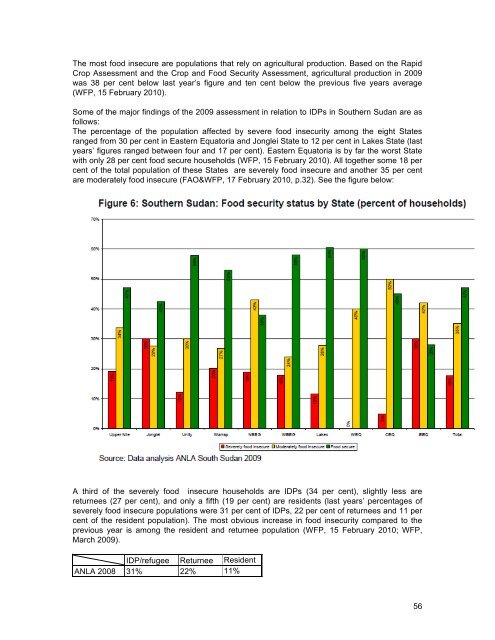SUDAN: Durable solutions elusive as southern IDPs return and ...
SUDAN: Durable solutions elusive as southern IDPs return and ...
SUDAN: Durable solutions elusive as southern IDPs return and ...
Create successful ePaper yourself
Turn your PDF publications into a flip-book with our unique Google optimized e-Paper software.
The most food insecure are populations that rely on agricultural production. B<strong>as</strong>ed on the Rapid<br />
Crop Assessment <strong>and</strong> the Crop <strong>and</strong> Food Security Assessment, agricultural production in 2009<br />
w<strong>as</strong> 38 per cent below l<strong>as</strong>t year’s figure <strong>and</strong> ten cent below the previous five years average<br />
(WFP, 15 February 2010).<br />
Some of the major findings of the 2009 <strong>as</strong>sessment in relation to <strong>IDPs</strong> in Southern Sudan are <strong>as</strong><br />
follows:<br />
The percentage of the population affected by severe food insecurity among the eight States<br />
ranged from 30 per cent in E<strong>as</strong>tern Equatoria <strong>and</strong> Jonglei State to 12 per cent in Lakes State (l<strong>as</strong>t<br />
years’ figures ranged between four <strong>and</strong> 17 per cent). E<strong>as</strong>tern Equatoria is by far the worst State<br />
with only 28 per cent food secure households (WFP, 15 February 2010). All together some 18 per<br />
cent of the total population of these States are severely food insecure <strong>and</strong> another 35 per cent<br />
are moderately food insecure (FAO&WFP, 17 February 2010, p.32). See the figure below:<br />
A third of the severely food insecure households are <strong>IDPs</strong> (34 per cent), slightly less are<br />
<strong>return</strong>ees (27 per cent), <strong>and</strong> only a fifth (19 per cent) are residents (l<strong>as</strong>t years’ percentages of<br />
severely food insecure populations were 31 per cent of <strong>IDPs</strong>, 22 per cent of <strong>return</strong>ees <strong>and</strong> 11 per<br />
cent of the resident population). The most obvious incre<strong>as</strong>e in food insecurity compared to the<br />
previous year is among the resident <strong>and</strong> <strong>return</strong>ee population (WFP, 15 February 2010; WFP,<br />
March 2009).<br />
IDP/refugee Returnee Resident<br />
ANLA 2008 31% 22% 11%<br />
56
















